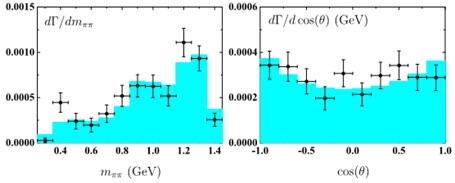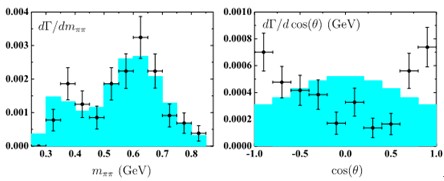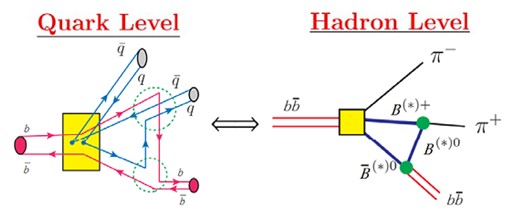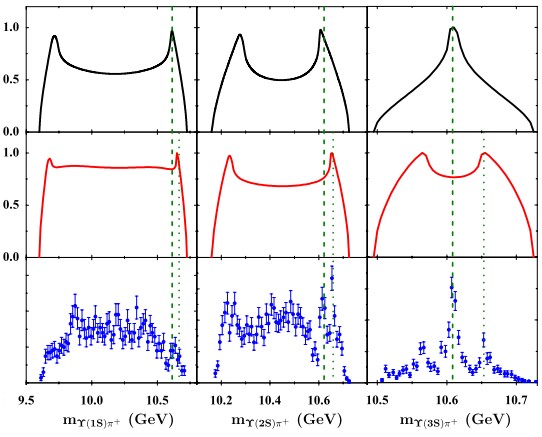The researchers at Institute of Modern Physics, Chinese Academy of Sciences (IMP) have systematically investigated the hidden bottom dipion decay of S wave bottomonium, and proposed the mechanism in the decay of Υ(5S).
Using the interaction effect of the direct decay, the final state interactions and the newly proposed initial single pion emission mechanism in these decay process, the experimental measurements about the dipion invariant mass and the helicity angle distributions can be well reproduced simultaneously. The decay widths of the dipion transitions between Υ(5S) and Υ(nS), (n=1,2) are about two orders larger than expected. To explain such a phenomena, the researchers proposed that in the hidden bottom dipion decay of Υ(5S), besides the direct decay process, the contribution from the final state interactions is also unneglectable. With these two decay mechanism, the researchers fitted the dipion invariant mass and helicity angle distributions of the dipion transition between Υ(5S) and Υ(1S). The theoretical results can well describe the experimental measurements (As shown in Fig. 1). However, for the dipion transition between Υ(5S) and Υ(2S), only the dipion invariant mass can be reproduced, the helicity angle distributions from theoretical prediction is totally different with the experimental measurements (As show in Fig. 2).
The Belle Collaboration reported two newly observed structures in the dipion transition between Υ(5S) and the lower excited S- and P-wave bottomonia. These two structures are named as Zb(10610) and Zb(10650) according to their masses. By analyzing the results of the experimental measurement, the researchers in IMP proposed that the cascade decay process via the two newly observed structures Zb(10610) and Zb(10650) is also essential in the study of the dipion transition of Υ(5S) and Υ(2S). After including such process, the theoretical estimations can well reproduce the dipion invariant mass distribution, Υ(2S) and pion invariant mass distribution as well as the helicity angle distribution simultaneously (As show in Fig. 3). These results also provide some direct evidences for the existence of Zb(10610) and Zb(10650).
For the newly observed structures in the Υ(5S) hidden bottom dipion decay process, after systematically study of the decay of Υ(5S), the researchers in IMP proposed a new decay mechanism, i.e., the initial single pion emission mechanism. The phenomenologically description is shown in Fig. 4. With such a new decay mechanism, the invariant mass distributions of lower S- or P-wave bottomonia and a pion are estimated. The predicted peak structures are perfectly corresponding to those observed by Belle Collaboration.
If the newly proposed initial single pion emission mechanism is universal, such a mechanism can be extended to study the similar dipion decay process. The researchers extend this mechanism to study the decay Υ(11020)and higher excited charmonium as well as charmonium-like state. Some peak structures are predicted in these similar decay processes. Some of these structures are consistent with the primary results of CLEO-c Collaboration and Belle Collaboration.
The related articles have been published in Physical Review D: Physical Review D84 034032(2011); D84 074006(2011); D84 074016(2011); D84 074032(2011); D84 094003(2011);
The articles can be linked as follows:
http://prd.aps.org/abstract/PRD/v84/i9/e094003
http://prd.aps.org/abstract/PRD/v84/i7/e074032
http://prd.aps.org/abstract/PRD/v84/i7/e074016
http://prd.aps.org/abstract/PRD/v84/i7/e074006
http://prd.aps.org/abstract/PRD/v84/i3/e034032

Fig.1 The theoretical fits to the dipion invariant mass distribution and helicity angle distribution of Υ(5S)→Υ(1S) π+π-. (Image by IMP)

Fig.2 The theoretical fits to the dipion invariant mass distribution and helicity angle distribution of Υ(5S)→Υ(2S) π+π-. (Image by IMP)

Fig.3 The theoretical fits to dipion invariant mass, the Υ(2S) π invariant mass and the helictiy angle distribution after including the cascade decay via Zb(10610) and Zb(10650). (Image by IMP)

Fig 4. A phenomenological description of initial single pion emission mechanism. The left panel is the one describe in quark level while the right panel is in hadron level. (Image by IMP)

Fig 5. The invariant mass distributions predicted by initial single pion emission mechanism. (Image by IMP)

